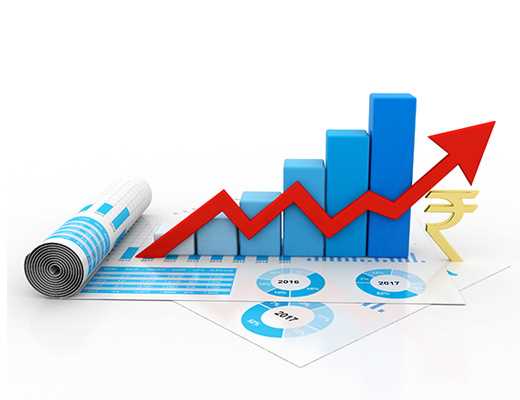Search here

27-May-2024 , Updated on 5/28/2024 12:29:29 AM
A short history of the Indian economy 1947-2024.
The case of the Indian economy, which is among the fastest growing in the globe, has perhaps experienced the most transformation after gaining independence. This process of coming from rags to an economic giant can be said to have been through some challenges. Day by day and year by year, citizens and governments have made tireless and regular strikes to construct today’s India.
This blog will focus on an overview of the Indian Economy growth from the period 1947 up to the year 2024.
1. Rebuilding an Economy – 1947
India’s contribution in 1700 was 22. In GDP terms, it occupied 6% of the global economic output, but it was cut to just 3. 8% by 1952. As for the ministry’s finances, they faced the problem of exhaustion of the treasury in India after gaining independence. The manner of economic direction during the initial years was set by first Finance Minister R K Shanmukham Chetty whose policy concentrated more on import substitution industrialization, establishing of a number of governments controlled public sectors.
The fourteen banks were nationalized by the year 1969 and the GDP in India had reached to the level of INR 5,844. 8 crores.
2. The green revolution of farming 1965
In the post-independence period, Green Revolution was an important tool in the growth and development of Indian agriculture and economy. There were many political leaders during the history of India but few of them are ever praised for their leadership such as Lal Bahadur Shastri who in 1965 industrialized agriculture in India. The working of the policy was supervised by M. S. Swaminathan.
This led to a 70% increase in farmers’ income and helped the agricultural departments particularly in Punjab and Haryana states and also in Uttar Pradesh. However, the policy so formulated was not without controversy as the later developments would suggest.
3. The Emergence of Private Sector – 1980
By mid 1980s the government was attempting to formulate strategies for raising the employment indicator in the country. India was soon turning into a country with a fast-growing population but the employment ratio was not rising in the same manner.
Gradually the economy of the country started to develop. From 1980 to 2002 they recorded an annual growth of 6 percent and were among the best economies for more than two decades. At the same time, the procreated yearly population growth rate of 2 percent needed to be addressed. 2%, the government started campaigns such as the “Hum do humare do.” But it was accompanied by some criticisms.
4. After 1991.
The so-called LPG (Liberalization, Privatization and Globalization) did not all of the sudden start off as a grand plan from the government. Later in 1990, Chandra Shekhar Singh took the oath of Prime Minister of India. At that time, India was suffering from fiscal deficit mainly because of bad economic policies. The reservoirs were depleted and the IMF together with the WB ceased its support.
The government has to use gold reserves for the purpose of obtaining credit security without other ways. It airlifted 47 tons of gold to the Bank of England as well as 20 tons to Union Bank of Switzerland. Lastly, the Chandra Shekhar government fell; P. V. Narasimha Rao became the new Prime Minister of the country. He got Dr. Manmohan Singh as his Finance Minister and the later introduced several structural reforms in the Indian economy.
The LPG policy made India liberalize its economy to foreign investors and eliminated the License phenomenon; tariff and interest rates came down and public monopoly ceased. Funds began to be invested and there seems to have been much to do from the smaller investments as well as the major investment.
5. Leaving to one side the Great Recession – 2008.
The LPG received tremendous success and the stability of the Indian economy began to grow until year 2008, when the situation turned sour. India was not at receiving end but it served a wake-up call. the much sought-after IT industry, which is the most sparkling gem in India’s booming architectural structure, dismissed nearly 5 lakh employees. Also, the automobile market reduced the employment rate by 4. 28% construction sector by 1%, the textile industry by 1%. 29 % and the jewelry industry by 11. 9%.
6. Demonetization - 2016
The decision to demonetize currency had many citizens shocked and RBIs decision to demonetize a higher currency shocked the economy. It affected many areas regarding the fact that most of the population in India is involved in cash transactions.
At first, demonetization was applauded as it was done with the intention of ‘eliminating’ black money. Later, an RBI report revealed that 99% was returned to them, which means that the money had become white legally. Far from owning it, as was revealed in above sections most people with black money did not tangibly own it.
7. The Pandemic 2020-2022
Another recent addition to history is the COVID-19 pandemic. It unfolded its claws for more than 2 years. The lockdown situation made the nation struggle; the second and the third waves of the virus were even worse. It tried the patience and tolerance level of the economies something that could not be even dreamt of.
But the vaccination procedure became the inspiration source to bring the hope and desire among people as well as the business houses to refurbish.
From 2023 till now
Global Agencies, including the IMF, are now forecasting a higher growth rate for India and have maintained India’s position as the world’s most promising largest economy in the future. Core industries like manufacturing, digital, and renewable sources have observed improvements, and central schemes like PLI have been helpful. Indias export performance has also improved to great heights. The country has also become the influential player in digital economy International Markets
Conclusion
India’s economic timeline from 1947 to 2024 has its successes, achievements and changes along with restrictions and walls to cross. From starting the economic reconstruction of a nation ravaged by war to coping up with the challenges of the world economy modern India has set examples of courage and flexibility. These policies over the decades have set the stage for India to become a dominant economic player in the international system, but there are still some hurdles as India seeks for more sustainable development that would benefit everyone.

Student
An MBA in finance imparts and improves management aptitude, inventive ability, critical thinking ability, and so forth. It offers a real-time experience that fabricates a staunch career foundation for students and working professionals. It helps them to thoroughly understand the financial sector.
Join Our Newsletter
Subscribe to our newsletter to receive emails about new views posts, releases and updates.
Copyright 2010 - 2025 MindStick Software Pvt. Ltd. All Rights Reserved Privacy Policy | Terms & Conditions | Cookie Policy